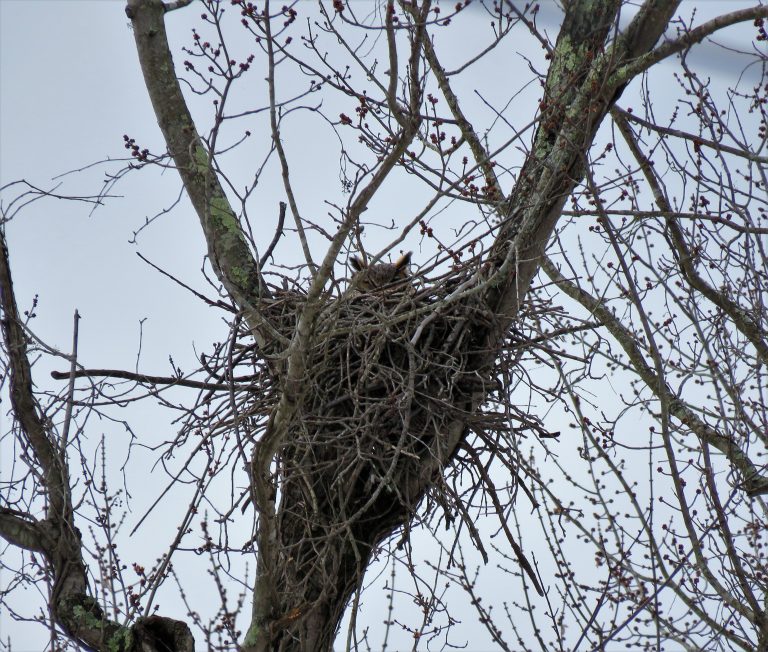By Ashley Peele/Jon and BJ Little

Great-horned owl on nest (The Littles)
Many birders find their interest piqued by a specific group of species. For some it is the hummingbirds, for others the coastal breeders, and for many, the birds of prey. This interest often leads to development of specialized methods for documenting and studying these species. For Jon and BJ Little, finding and confirming the nests of large raptor species, including Great-Horned Owl, Red-tailed Hawk, and Red-Shouldered Hawk has been a labor of love for many years. To better understand their great success in locating nests of species that many of us find difficult to confirm, we asked Jon and BJ to share some of their tips and strategies with the Atlas community.
Techniques for locating Great Horned Owl and Hawk nests
By Jon and BJ Little
- In our efforts to document buteo nests, we drive around and scan woodlots near hayfields and cattle farms in late fall and winter, after the leaves fall. We seldom find buteo nests near row crops or horse farms.
- We look for the gray, flat-topped, stick nests of buteos, not the brown, leafy spherical dens of squirrels. Spotting these target nests can be difficult, so a second pair of eyes in the car is enormously helpful.
- You are looking for a blob of sticks that can be anywhere from halfway up a trunk, or closer to the canopy, often but not always in a crotch.
- We record the location of all buteo nests and often find new nests that were built and used the previous Spring after leaf-out, which could not have been seen that year.
- Because Great Horned Owls don’t build nests, they usually usurp old buteo nests. The following January & February, we revisit those buteo nests to look for owl “ears,” the large tufts that can often be seen sticking up from an occupied nest.
- Most owls will be on nests by this time, but a few might wait until March.
- Great Horned Owls don’t usually like sites with a lot of nearby human activity, so we skip checking the nests close to houses. However, traffic doesn’t seem to bother some of them (like those nesting right along Route 7 in Purcellville).
- The owls will claim the nest well before the hawks do and often tear them up so much that they need a new one the next year.
- Buteos usually prefer sites away from humans, but a number of individual birds don’t seem to care about human presence and will nest very near houses. I have a particular example of that right here in Clarke Co. where a Red-shouldered Hawk nests right above the driveway. As a rule, owls avoid such locations.
- Cloudy days are actually better for nest searching, as the background of sky you are scanning through branches, makes the nests more visible. Speed is also a factor. We’ve often noticed nests while driving the interstates and secondary roads at posted limits. It may seem odd, but you can easily miss them driving under 20 MPH.
- After an owl takes over a buteo’s old nest, the previous tenant will often build a new nest somewhere nearby. I have dozens of examples of that from Minnesota and this pattern seems to hold true here as well. Therefore, in March and April, do check for new hawk nests in the area.
Note: These observations are primarily conducted in rural and agricultural areas of northwestern Virginia. Nest site preferences may vary in more urban/suburban landscapes.
Thanks much to Jon and BJ for both sharing their experience and contributing fantastic raptor breeding data to the VABBA2!

